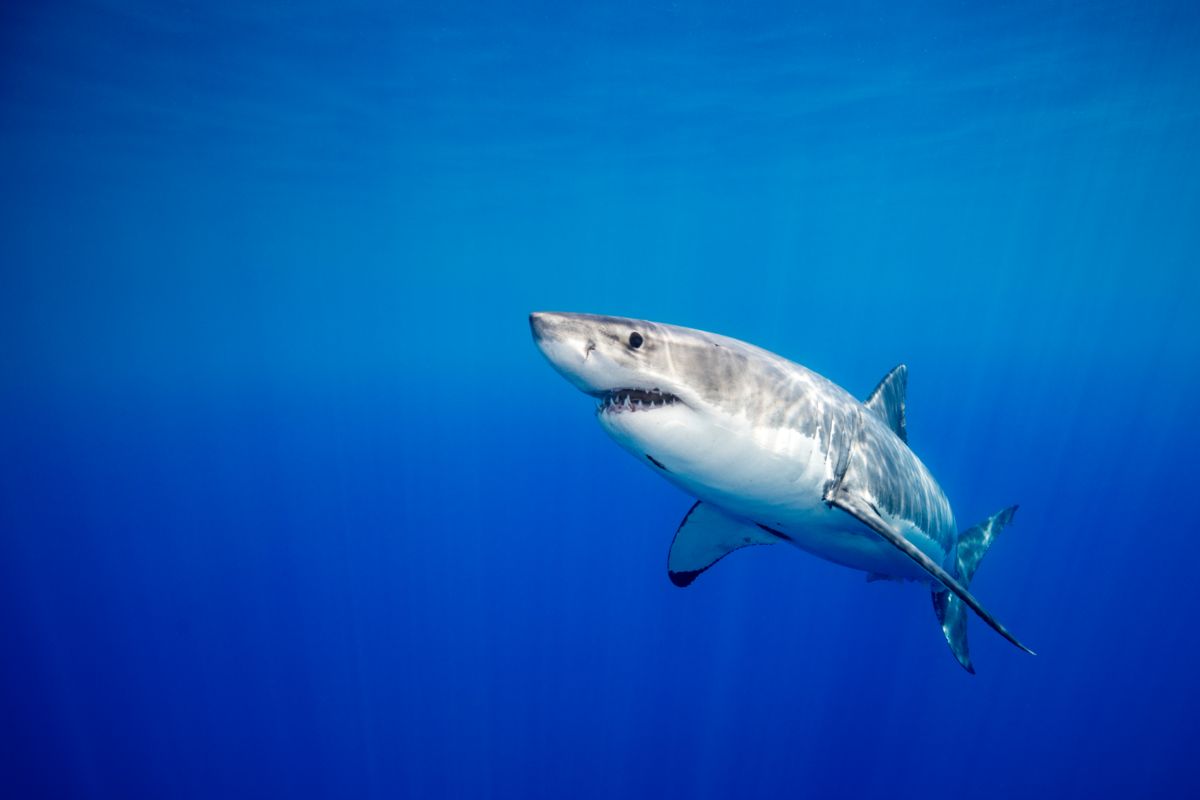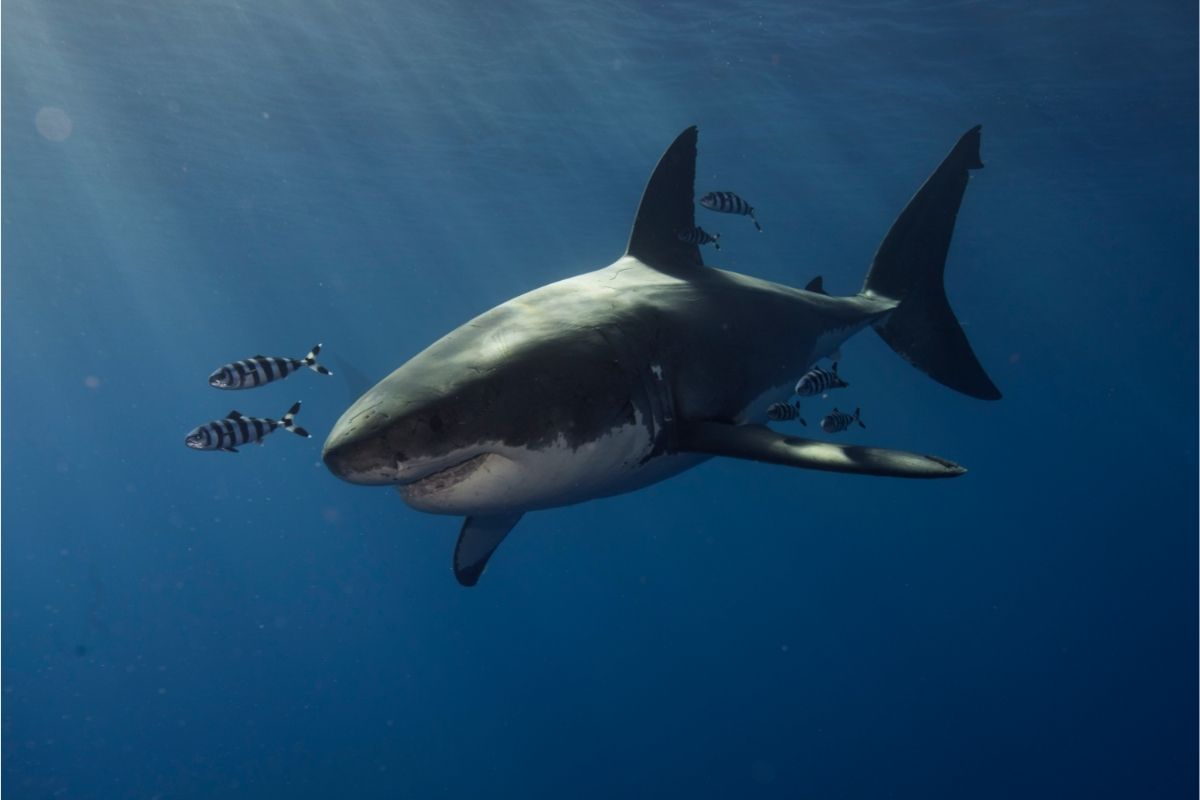Great white sharks, also known as white sharks, white pointers, or most commonly simply great whites, are a large species of mackerel shark.
Great whites have a fearsome reputation, and are arguably the most well-known shark in the world as a result of their reputation for attacking humans.

Because they are so well-known, people have more questions about great white sharks than just about any other shark species.
One question people often ask is how far great whites swim in a day. Naturally, because great whites must continually swim in order to breathe, they can cover some impressive distances.
Obviously, no two great whites are the same, and each will swim slightly different distances each day depending on their size and swimming speed.
Nevertheless, it is thought that on average great whites swim roughly 50 miles every day.
Although they don’t swim at this speed all the time, great whites can swim at speeds of up to 25km per hour in short bursts and can dive to depths of about 3900 feet. How do great whites swim so well?
They’re perfectly designed to be excellent swimmers. They use their powerful tails to propel themselves through the water quickly and efficiently.
They also have pointed, crescent-shaped tails that help the great white to cut through the water and remain streamlined.
Why Do Great White Sharks Need To Cover Such Long Distances?
Great white sharks would be far from at home in an aquarium or sea life park. They are migratory creatures, covering massive distances each year in the hunt for new feeding grounds.
When faced with nothing but the open ocean, great white sharks have been known to travel up to 2500 miles (4000 kilometers) in one go, sometimes quite literally in a straight line.
When migrating, great whites typically stick to near the surface of the ocean.
Unfortunately for great white sharks, vast swathes of the open seas are virtually devoid of any prey to sustain them. Instead, great whites sustain themselves with a ‘backup’ source of energy.
It comes from the liver, and comes in the form of lipids. Luckily, a great white shark’s liver is absolutely huge, making up more than a quarter of the shark’s total body weight.
As great white sharks migrate, they power themselves across the seas using this stored energy reserve.
How Fast Can A Great White Swim?
As with many apex predators, the great white is at its fastest when chasing prey over short distances.
In such instances, the great white can hit a top speed of about 25 kilometers per hour, which equates to roughly 16 miles per hour.
This does, however, vary from shark to shark. Naturally, the smaller and more streamlined great white sharks can travel at greater speeds than larger sharks carrying more weight.
Having said that, great whites swim at a much more leisurely pace when migrating, as they have no need to waste precious energy, especially in an environment that has a dearth of prey.
How Far Can A Great White See, And Does This Help Them While Migrating?

If you’ve ever seen a great white’s eyes, you will know how striking they are. They are impressively large and have a deep, navy blue hue.
You might even find yourself reminded of human eyes when looking at them. Although they are five times larger than human eyes, great white eyes have a somewhat similar structure to our own.
This goes some way to explaining their highly impressive vision.
So what are great white eyes like? The retina has two constituent parts, each with its own adaptation.
One part is designed for dealing with daylight, whilst the other part is adapted to deal with nighttime and the poor light conditions of deeper waters. As previously mentioned, the iris itself is a dark shade of navy blue.
One interesting adaptation that great whites have in terms of eyesight is their tendency to roll their eyes back into the socket in moments of danger, particularly when hunting prey.
In terms of hunting, another adaptation that great whites have is a layer of reflective crystals at the back of each eye socket.
These have the ability to detect even the slightest bit of movement from potential prey, and tell the shark exactly which direction it is coming from.
With such helpful adaptations, a great white can see for distances of up to 820 feet, which is about 250 meters away.
Such sharp vision is of course helpful whilst traveling across the ocean waves, and they can see their destination long before they actually reach it.
How Does A Great White Sustain Itself Over Long Distances?
As we discussed earlier, large swathes of the ocean are lacking in the kind of prey that a great white normally eats to sustain itself.
Consequently, great whites power their migrations with lipids stored in their huge livers. They build up this lipid store by eating large amounts when they are not migrating.
So what do great whites eat? Well, young great white sharks eat mostly small prey, like rays and fish.
Fully grown great whites, on the other hand, tend to go for much larger prey like seals, sea lions, sea turtles, and even some smaller species of whale.
Great whites are also, to a degree, scavengers, and will feed on any dead creatures they come across in the water.
Great whites eat a lot of this prey, too, eating up to 11 tonnes worth of meat in a single year.
Sharks usually subdue their prey by attacking quickly and forcefully, hoping to inflict massive wounds that will either force the prey into shock or lead it to bleed to death a short time later.
When the creature does bleed out, the shark then simply follows the smell of blood and returns to feast on its carcass.
Another adaptation that great whites have that helps them to hunt their prey is the presence of ampullae. These two ‘sensors’ in the skull detect electrical pulses, which the great can use to detect the thrashing of wounded prey.
Of course, it would be remiss of us to talk about great whites without mentioning their teeth. Their massive teeth, of ‘Jaws’ fame, are triangular and feature serrated edges for slicing through flesh.
A great white has literally dozens of teeth, with rows of replacement teeth further behind.
You can see why a great white would need replacement teeth, as their teeth go through a large amount of wear and tear and are prone to breaking.

When older teeth break, there are always newer ones waiting in the wings to take their place. In fact, a great white can have over 300 teeth.
Unlike humans, great whites don’t have to brush their teeth.
Each tooth has a cavity-resistant fluoride coating, and its enamel contains a chemical known as fluorapatite which is naturally resistant to the acid produced by bacteria build-up.
Do Great Whites Often Travel Long Distances?
Yes, great whites regularly travel long distances. They are, for starters, an inherently migratory species. On top of this, great whites get their oxygen from a technique called ‘ram ventilation’.
This means that the shark needs to swim constantly in order to breathe, as it is the act of swimming itself that forces water across the gills.
Therefore, they can never stop swimming, so they naturally cover long distances. This is unlike other species of fish, that have more complex systems to pump water into and out of the gills.
Great whites, although migratory and often solitary, still have a bunch of social and behavioral systems.
Female great whites, larger than their male counterparts, tend to dominate, whilst sharks resident in a given area will also dominate sharks that have only recently arrived.
One way that great white sharks display their dominance is with a bite. The best way to describe the social structure of great white sharks is probably as ‘like a wolf pack’.
They mostly live peacefully in a group, although there is a clear hierarchy and each group has a ‘top shark’ that leads as an alpa.
Great Whites are more intelligent and naturally curious than many people give them credit for, and they need this intelligence in order to relate to other sharks.
Interestingly, great whites are one of only a few shark species that ever exits the water.
Despite weighing in at 2000lbs or more, great whites on the hunt for fast-moving prey like seals are known to launch themselves up to 10 feet into the air in a process known as ‘breaching’.
Why Are They Called White Sharks?
Great whites are, as the name suggests, largely white in appearance. Well, at least the underside is. Their top side is a darker, gray color. This coloring functions as a camouflage.
From below, the white underside of the shark blends in with the bright rays of sun coming from above. From above, the dark gray blends in well with the deeper and darker depths of the ocean below them.
Can Great White Sharks Survive In Freshwater?
No, great whites can’t survive for any length of time in freshwater, as they are adapted to the saltwater environment of the sea.
In fact, a shark’s body needs salt in order to function. Without it, their cells will begin to rupture and their bodily functions will begin to fail. The result, soon after, would be the great white’s death.
That’s without even mentioning the fact that sharks don’t have a swim bladder for buoyancy.
As freshwater is less buoyant than saltwater, the great white would have serious problems keeping itself afloat in freshwater. In fact, it would be 2 or 3 times less buoyant.
Final Thoughts
Estimates suggest that great white sharks can travel up to about 50 miles a day. They need to be able to travel so far for two reasons.
Firstly, to migrate to new hunting grounds where food is more plentiful. Secondly, as ram ventilators, great whites need to be constantly on the move in order to breathe.
- Is It Possible For A Shark To Swim Backwards? - August 2, 2022
- Are Leopard Sharks Dangerous? - August 2, 2022
- What Are The Differences Between Shark And Dolphin Fins? - August 1, 2022








